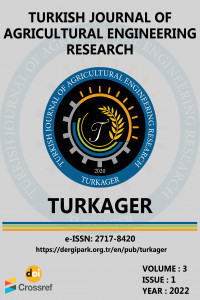Development of Olive Harvesting Machine by Shaking
Development of Olive Harvesting Machine by Shaking
Olive, Shaking Frequently, Stroke, Fruit removal,
___
- Almeidaa A, Figueiredoa T and Fernandes-Silva A (2015). Data used as an indicator of mechanical olive harvest season. Agriculture and Agricultural Science Procedia, 7: 2-5.
- Alzoheiry A, Ghonimy MI, Abd El Rahman EN, Abdelwahab O and Hassan AM (2020). Improving olive mechanical harvesting using appropriate natural frequency. Journal of Agricultural Engineering, 51(3): 148-154.
- Babanatsas T, Glavan DO, Merce RMB and Glavan AI (2019). Study of Forces Influencing the Shaking Parameters in Mechanized/Robot-assisted Harvesting of Olives. In MATEC Web of Conferences, 290: 03001. EDP Sciences.
- Bernardi B, Falcone G, Stillitano T, Benalia S, Strano A, Bacenetti J and De Luca AI (2018). Harvesting system sustainability in Mediterranean olive cultivation. Science of the Total Environment, 625: 1446-1458.
- Cicek G (2011). Determination of harvesting costs and cost analysis for different olive harvesting methods. Journal of Food, Agriculture & Environment, 9 (3-4): 201-204.
- Erdoǧan D, Güner M, Dursun E and Gezer I (2003). Mechanical harvesting of apricots. Biosystems Engineering 85: 19-28. https://doi.org/10.1016/S1537-5110(03)00024-2.
- FAOSTAT (2018). FAO Statistical Yearbook. Agricultural production. http://www.fao.org/faostat. (August 2018).
- Ferguson L, Rosa UA, Castro-Garcia S, Lee SM, Guinard JX, Burns J, Krueger WH, O’Connell NV and Glozer K (2010). Mechanical harvesting of California table and oil olives. Advances in Horticultural Science, 24(1): 53-63.
- Gawankar MS, Haldankar PM, Salvi BR, Parulekar YR, Dalvi NV, Kulkarni MM, Saitwal YS and Nalage NA (2019). Effect of girdling on induction of flowering and quality of fruits in horticultural crops-a review. Advanced Agricultural Research & Technology Journal, 3(2): 201-215.
- Ghonimy M, Ibrahim M, Drees A and Marey S (2021). Development of a pneumatic olive harvester. Engenharia Agrícola, 41: 347-358.
- Ghonimy MI (2006). Prediction of the suitable amplitude of shaking unit for fruit harvesting. Misr Journal of Agricultural Engineering, 23(1): 1-18.
- Ghonimy MI, Abd El Rahman EN, Ibrahim MM and Hassan AM (2020). Development of olives harvesting machine for smallholdings. Plant Archives, 20(2): 3576-3583.
- Guirado RRS, Jiménez FJ, Blanco-Roldan GL, Castro-Garcia S, Ruiz FJC and Gil-Ribes JA (2016). Vibration parameters assessment to develop a continuous lateral canopy shaker for mechanical harvesting of traditional olive trees. Spanish Journal of Agricultural Research, 14(2): e0204.
- Leone A, Romaniello R, Tamborrino A, Catalano P and Peri G (2015). Identification of vibration frequency, acceleration, and duration for efficient olive harvesting using a trunk shaker. Transactions of the ASABE, 58(1):1-8. DOI: https://doi.org/10.13031/trans.58.10608.
- Morad MM and El-Termezy G (2020). Manufacturing and performance evaluation of a tractor-mounted olive harvesting machine. Egyptian Journal of Agricultural Research, 98(3): 533-547.
- Nasini L and Proietti P (2014). Olive harvesting, Chapter 8 in the Extra-Virgin Olive Oil Handbook. John Wiley & Sons Ltd. UK.
- O'brien M, Cargill BF and Fridley RB (1983). Principles and Practices for Harvesting & Handling Fruits and Nuts. AVI bub. Comp, INC., Westport, Connecticut.
- Polat R, Gezer I, Erdogan D, Guner M, Dursun E and Bilim HIC (2007). Mechanical harvesting of pistachio nuts. Journal of Food Engineering, 79: 1131-1135.
- Ruiz FJC, Tombesi S and Farinelli D (2018). Olive fruit detachment force against pulling and torsional stress. Spanish Journal of Agricultural Research, 16(1): e0202.
- Shigley JE and Mitchell LD (1983). Mechanical Engineering Design. 4th ed. McGraw - Hill Book Company, New York.
- Sola-Guirado RR, Aragon-Rodriguez F, Castro-Garcia S and Gil-Ribes J (2019). The vibration behaviour of hedgerow olive trees in response to mechanical harvesting with straddle harvester. Biosystems Engineering, 184: 81-89.
- Testa R, Trapani AMD, Sgroi F and Tudisca S (2014). Economic analysis of process innovations in the management of olive farms. American Journal Applied Sciences, 11(9): 1486-1491.
- Younis SM, Abdelbary KM, ELMesery SA and Abdelahady AA (2017). Design and evaluation a hand-held machine for olives harvesting. Misr Journal of Agricultural Engineering, 34(1): 103-122.
- Zipori I, Dag A, Tugendhaft Y and Birger R (2014). Mechanical harvesting of table olives: Harvest efficiency and fruit quality. HortScience, 49(1): 55-58.
- Yayın Aralığı: Yılda 2 Sayı
- Başlangıç: 2020
- Yayıncı: Ebubekir ALTUNTAŞ
Diyabetik Bal Kabağı (Cucurbita moschata Duch.) Marmelatı Üretimi
Ali CİNGÖZ, Aslihan DEMİRDÖVEN
Development of Olive Harvesting Machine by Shaking
Mohamed GHONİMY, Samy YOUNİS, Elsayed GHONİEM
Christopher OBİNECHE, Patricia ORİAKU
Nura Jafar SHANONO, Baba Saleh ABBA, Nuraddeen Mukhtar NASİDİ
Saheed Abiola OLAOYE, Olanrewaju OWOSENİ, Ayoola OLALUSİ
Fuel Properties of Sandbox (Hura crepitans Linn.) Methyl Ester and its Blends
David ONWE, Adeleke Isaac BAMGBOYE
Motorbike Powered Trailer for Transporting Poultry Birds
Ayoola JONGBO, Timothy ADELAJA
Farmers' Participation in Watershed Management in Sodo Zuria District of Southern Ethiopia
Danıel BALTA, Senapathy MARİSENNAYYA, Pandikumar M MARISENNAYYA, Chinaza GODSWİLL AWUCHİ
